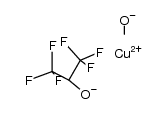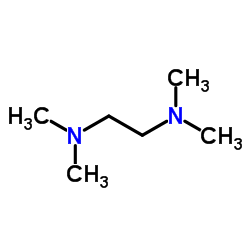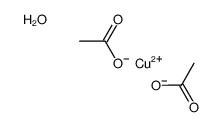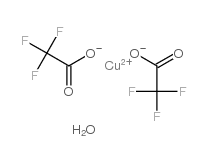COPPER(II) METHOXIDE

COPPER(II) METHOXIDE structure
|
Common Name | COPPER(II) METHOXIDE | ||
|---|---|---|---|---|
| CAS Number | 1184-54-9 | Molecular Weight | 127.63000 | |
| Density | N/A | Boiling Point | N/A | |
| Molecular Formula | C2H8CuO2 | Melting Point | 206ºC (dec.)(lit.) | |
| MSDS | Chinese USA | Flash Point | N/A | |
| Symbol |

GHS07 |
Signal Word | Warning | |
| Name | copper,methanol |
|---|---|
| Synonym | More Synonyms |
| Melting Point | 206ºC (dec.)(lit.) |
|---|---|
| Molecular Formula | C2H8CuO2 |
| Molecular Weight | 127.63000 |
| Exact Mass | 126.98200 |
| PSA | 40.46000 |
| Appearance of Characters | Powder | Green |
| Water Solubility | Reacts with water. |
|
Section 1: Product Identification Chemical Name:Copper(II) methoxide, 99% CAS Registry Number:1184-54-9 Formula:Cu(OCH3)2 EINECS Number:none Chemical Family:metal alkoxide Synonym:Cupric methylate
Section 2: Composition and Information on Ingredients IngredientCAS NumberPercentACGIH (TWA)OSHA (PEL) Title compound1184-54-9100%no datano data Section 3: Hazards Identification Irritating to skin, eyes and respiratory tract. Moisture will produce methanol vapor which may cause blindness, Emergency Overview: intoxication, dizziness and coma. Primary Routes of Exposure:Ingestion, inhalation, contact with skin and eyes. Eye Contact:Causes severe irritation to the eyes. Delayed blindness may occur through atrophy of the optic nerve. Skin Contact:Dehydrating agent. Liquid causes slight to mild irritation of the skin. Inhalation:Methanol vapor is irritating to the respiratory tract and may cause headache, dizziness, coma and blindness. Ingestion:Ingestion may cause nausea, vomiting, headache, coma and death. Irritating to skin, eyes and respiratory tract. Methanol vapors may cause blurred vision, blindness, intoxication, Acute Health Affects: dizziness, headache, nausea, coma and death. Rapid hydrolysis on human contact produces methanol which may cause atrophy of the optic nerve producing Chronic Health Affects:blindness. The dust of copper compounds may cause metal fume fever, hemolysis of the red blood cells and injury to the liver, lungs, kidneys and pancreas. NTP:No IARC:No OSHA:No SECTION 4: First Aid Measures Immediately flush the eyes with copious amounts of water for at least 10-15 minutes. A victim may need Eye Exposure: assistance in keeping their eye lids open. Get immediate medical attention. Wash the affected area with water. Remove contaminated clothes if necessary. Seek medical assistance if Skin Exposure: irritation persists. Remove the victim to fresh air. Closely monitor the victim for signs of respiratory problems, such as difficulty Inhalation: in breathing, coughing, wheezing, or pain. In such cases seek immediate medical assistance. Seek medical attention immediately. Keep the victim calm. Give the victim water (only if conscious). Induce Ingestion: vomiting only if directed by medical personnel. SECTION 5: Fire Fighting Measures Flash Point:not applicable Autoignition Temperature:no data Explosion Limits:no data Extinguishing Medium:carbon dioxide, dry powder or foam If this product is involved in a fire, fire fighters should be equipped with a NIOSH approved positive pressure Special Fire Fighting Procedures: self-contained breathing apparatus and full protective clothing. Hazardous Combustion andIf involved in a fire, this material may emit toxic organic fumes and copper oxide dust. Decomposion Products: Unusual Fire or Explosion Hazards: exposure to moisture may produce flammable methanol SECTION 6: Accidental Release Measures Spill and Leak Procedures:Avoid contact with water. Small spills can be mixed with vermiculite or sodium carbonate and swept up. SECTION 7: Handling and Storage Store the material cold, in a tightly sealed container. Handle the material in a ventilated area. If container is left Handling and Storage: open product may absorb moisture and carbon dioxide from atmosphere and release methanol vapor. SECTION 8: Exposure Controls and Personal Protection Eye Protection:Always wear approved safety glasses when handling a chemical substance in the laboratory. Skin Protection:Wear protective clothing and gloves. Ventilation:Handle the material in an efficient fume hood. If ventilation is not available a respirator should be worn. The use of respirators requires a Respirator Respirator: Protection Program to be in compliance with 29 CFR 1910.134. Ventilation:Handle the material in an efficient fume hood. Additional Protection:No additional protection required. SECTION 9: Physical and Chemical Properties Color and Form:blue powder Molecular Weight:125.61 Melting Point:no data Boiling Point:no data Vapor Pressure:not applicable Specific Gravity:no data Odor:alcohol-like odor Solubility in Water:decomposes in water SECTION 10: Stability and Reactivity Stability:moisture sensitive (store cold) Hazardous Polymerization:no hazardous polymerization Conditions to Avoid:keep away from moisture Incompatibility:oxidizing agents, active metals and chlorine Decomposition Products:carbon dioxide, carbon monoxide, organic fumes and copper salts. SECTION 11: Toxicological Information RTECS Data:No information available in the RTECS files. Carcinogenic Effects:no data Mutagenic Effects:no data Tetratogenic Effects:no data SECTION 12: Ecological Information Ecological Information:No information available SECTION 13: Disposal Considerations Disposal:Dispose of according to local, state and federal regulations. SECTION 14: Transportation Shipping Name (CFR):Non-hazardous Hazard Class (CFR):NA Additional Hazard Class (CFR):NA Packaging Group (CFR):NA UN ID Number (CFR):NA Shipping Name (IATA):Non-hazardous Hazard Class (IATA):NA Additional Hazard Class (IATA):NA Packaging Group (IATA):NA UN ID Number (IATA):NA SECTION 15: Regulatory Information TSCA:Not listed in the TSCA inventory SARA (Title 313):See category code N100 for reporting. Second Ingredient:none SECTION 16 - ADDITIONAL INFORMATION N/A |
| Symbol |

GHS07 |
|---|---|
| Signal Word | Warning |
| Hazard Statements | H315-H319-H335 |
| Precautionary Statements | P261-P305 + P351 + P338 |
| Personal Protective Equipment | dust mask type N95 (US);Eyeshields;Gloves |
| Hazard Codes | Xi |
| Risk Phrases | R36/37/38 |
| Safety Phrases | S26 |
| RIDADR | UN3180 |
| WGK Germany | 3 |
| Packaging Group | II |
| Hazard Class | 4.1 |
|
~83% 
COPPER(II) METHOXIDE CAS#:1184-54-9 |
| Literature: Journal of the Chemical Society, Dalton Transactions: Inorganic Chemistry (1972-1999), , p. 921 - 926 |
|
~0% 
COPPER(II) METHOXIDE CAS#:1184-54-9 |
| Literature: Inorganic Chemistry, , vol. 31, p. 4503 - 4509 |
|
~% 
COPPER(II) METHOXIDE CAS#:1184-54-9 |
| Literature: Synthesis and Reactivity in Inorganic and Metal-Organic Chemistry, , vol. 16, p. 1217 - 1224 |
|
~% 
COPPER(II) METHOXIDE CAS#:1184-54-9 |
| Literature: Zeitschrift fuer Anorganische und Allgemeine Chemie, , vol. 581, p. 48 - 50 |
|
~% 
COPPER(II) METHOXIDE CAS#:1184-54-9 |
| Literature: Polyhedron, , vol. 21, # 20 p. 2017 - 2020 |
| copper methoxide |
| cupric methoxide |
| MFCD00015611 |






 CAS#:16712-25-7
CAS#:16712-25-7 CAS#:41119-18-0
CAS#:41119-18-0